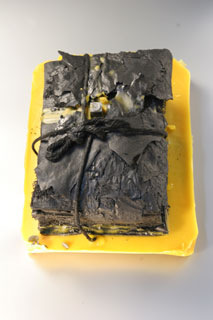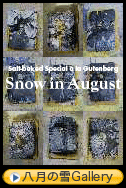

The medium of the book saw explosive growth due to Gutenberg’s invention of the printing press in mid-15th century Germany. This burst of effusiveness, on a scale never seen since human beings acquired language, gave rise to the colossal civilization that we know today. With the advance of IT, the book is now on the point of being superseded as the primary medium of civilization. To mark the end of the Gutenberg era, I have turned its medium, books, to charcoal, both in homage to the services they have performed, and in hopes of converting them into a kind of filter to purify the effusion-filled environment they have created over the years.

Though both charcoal and paper come from wood, it is not easy to obtain solid forms from sheets of paper through a charcoal-burning process. After much trial and error, I learned from an old folktale that paper impregnated with salt would retain more or less its original shape as it burned. Borrowing the traditional Japanese cooking technique of shiogamayaki (baking fish in a salt crust), I decided to “cook,” or rather fire, salt-encrusted books, and I named the result “salt-baked special à la Gutenberg.” As the folktale that taught me this trick of the trade is itself a medium distinct from books, I decided, at the same time, to return to the ancient origins of media by adding layers of quipu (knotted cords used for record-keeping by the Incas) to form a more expressive whole.
At some point, I noticed something I had not foreseen when I started work: water was seeping out of the slabs of carbonized book. We were in the middle of the rainy season on the Pacific coast of Boso Peninsula, where I have my studio, and the weather map showed a “wet tongue” (a phenomenon characteristic of the Far East) extending deep into the East China Sea, while over the sea to the south, within view, lay the seasonal rain front. The air temperature was 36°C (97°F) with 75% humidity: exactly the right conditions for the salt content of the charcoal to recombine with water. It was very salty water, of course: 17 on the Baumé scale, almost six times the concentration of seawater.
What’s more, while the works were being exhibited, when the rainy season had given way to the intense heat of August, a pure white powder began gradually appearing on their surfaces, until in the end they were coated with it. I couldn’t help exclaiming, “Snow!”
My guess is that the liquid sweated out over the preceding weeks had turned to salt in the fierce August heat.
In that case, it occurs to me that perhaps “Salt-baked Special à la Gutenberg,” which I originally intended to serve in some small way as a purifier of civilization, might live on, if not forever, then for a while, as another “medium,” activating a cycle of metamorphoses–salt, water, salt, water…–in keeping with the cycle of the seasons in these Far Eastern isles.
